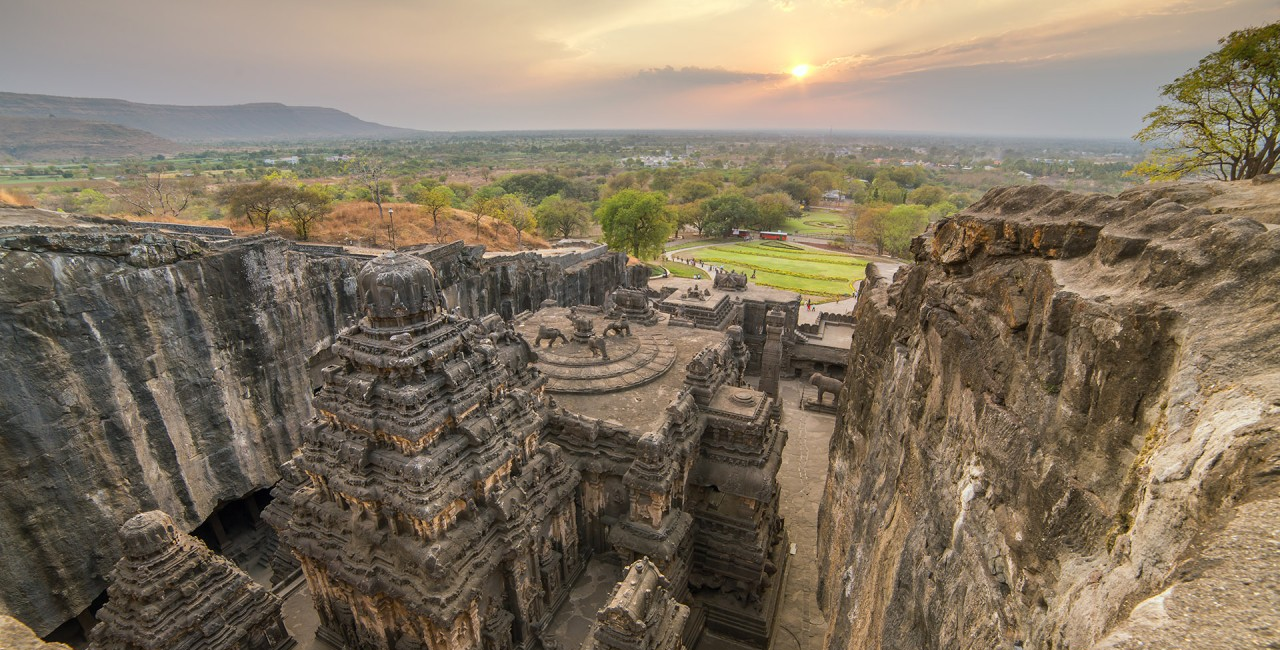The Ellora Caves, located in the Aurangabad district of Maharashtra, India, are among the most remarkable examples of ancient rock-cut architecture in the world. A UNESCO World Heritage Site, the caves are a testament to the ingenuity, creativity, and religious harmony of ancient India. Carved between the 6th and 10th centuries CE, these 34 monasteries and temples are a harmonious confluence of Hinduism, Buddhism, and Jainism, showcasing the rich cultural and spiritual diversity of the time.
Historical and Architectural Significance
Ellora, locally known as Verul, is a sprawling complex carved into the Charanandri Hills. Unlike many ancient sites, the caves are not natural formations but were meticulously excavated out of basalt rock using hammers and chisels. The artisans and sculptors transformed solid rock into intricate shrines, courtyards, halls, and statues, making Ellora an unparalleled marvel of engineering and art.
The construction spanned several centuries, with different dynasties contributing to its development. The Rashtrakuta dynasty played a significant role in the creation of Hindu caves, including the iconic Kailasa Temple (Cave 16), while the earlier Buddhist caves date back to the Kalachuri and Chalukya periods.
A Trilogy of Faiths
The Ellora Caves are unique because they represent three major religions of ancient India—Buddhism, Hinduism, and Jainism—reflecting the region’s religious tolerance and cultural plurality.
- Buddhist Caves (Caves 1–12)
The Buddhist caves, situated at the southern end, are among the earliest excavations in Ellora. They served as viharas (monasteries) and chaityas (prayer halls). Cave 10, also known as the Vishvakarma Cave or Carpenter’s Cave, is a highlight. It features a magnificent chaitya hall with a massive seated Buddha in the teaching posture. The ribbed ceiling of the cave mimics wooden architecture, showcasing the craftsmanship of ancient builders. - Hindu Caves (Caves 13–29)
The Hindu caves lie in the center and are notable for their grandiose scale and intricate carvings. The Kailasa Temple (Cave 16) is the crown jewel of Ellora. Dedicated to Lord Shiva, it is the largest monolithic structure in the world, carved from a single rock. The temple features towering pillars, detailed sculptures of gods, goddesses, and mythological scenes, including the celestial dance of Shiva (Tandava). The sheer scale and precision of the Kailasa Temple leave visitors awestruck. - Jain Caves (Caves 30–34)
The Jain caves, located in the northernmost part of Ellora, are smaller but equally exquisite. These caves emphasize simplicity and austerity, in line with Jain philosophy, yet they feature elaborate carvings and decorative motifs. Cave 32, also known as the Indra Sabha, houses a seated figure of Lord Mahavira, the 24th Tirthankara. The detailed lotus carvings and depictions of Jain deities demonstrate the fine artistry of the sculptors.
Artistry and Symbolism
The sculptures and frescoes at Ellora are not just artistic masterpieces but also serve as storytelling tools. Mythological narratives, cosmic symbolism, and cultural tales are intricately depicted on the walls and ceilings. These carvings provide a window into the spiritual and philosophical ideas of ancient India, as well as the daily lives of its people.
Cultural and Historical Insights
Ellora was more than just a religious site; it was a thriving cultural center. Monks, pilgrims, and travelers from across the Indian subcontinent and beyond visited the caves. The site offers valuable insights into the architectural techniques, social structures, and religious practices of the period.
The coexistence of Buddhist, Hindu, and Jain caves in one complex is a powerful testament to the harmonious intermingling of faiths that characterized early medieval India. This spirit of inclusivity is one of Ellora’s most enduring legacies.
How to Visit Ellora Caves
Ellora is easily accessible from the city of Aurangabad, located about 30 kilometers away. The nearest airport and railway station are in Aurangabad, well-connected to major cities in India. Visitors can explore the caves on foot, with local guides offering detailed insights into their history and significance.
The best time to visit is between October and March, when the weather is pleasant. The annual Ellora Ajanta Festival, held near the caves, celebrates the region’s cultural heritage through music, dance, and art.
Conclusion
The Ellora Caves are more than an archaeological wonder; they are a tribute to the human spirit and its relentless pursuit of beauty, spirituality, and knowledge. A visit to this timeless monument is a journey into India’s rich past, leaving one inspired by its architectural brilliance and the harmonious coexistence of diverse traditions.


0 Comment